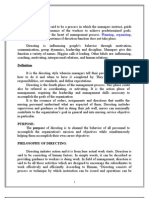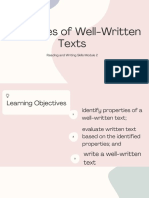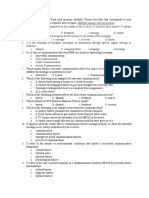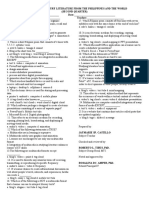0 ratings0% found this document useful (0 votes)
95 viewsDirection: Encircle The Letter of The Correct Answer: Name
Direction: Encircle The Letter of The Correct Answer: Name
Uploaded by
Squirmy Cape9097This document appears to be a quiz or test on non-verbal communication skills. It contains 10 multiple choice questions testing understanding of concepts like:
1) Non-verbal communication includes body language, facial expressions, and gestures.
2) Maintaining eye contact, posture, and appropriate speed of speech are important non-verbal communication skills in customer service.
3) Non-verbal cues like gestures, eye contact, posture, facial expressions and physical appearance are examples of physical/non-verbal communication.
Copyright:
© All Rights Reserved
Available Formats
Download as DOCX, PDF, TXT or read online from Scribd
Direction: Encircle The Letter of The Correct Answer: Name
Direction: Encircle The Letter of The Correct Answer: Name
Uploaded by
Squirmy Cape90970 ratings0% found this document useful (0 votes)
95 views1 pageThis document appears to be a quiz or test on non-verbal communication skills. It contains 10 multiple choice questions testing understanding of concepts like:
1) Non-verbal communication includes body language, facial expressions, and gestures.
2) Maintaining eye contact, posture, and appropriate speed of speech are important non-verbal communication skills in customer service.
3) Non-verbal cues like gestures, eye contact, posture, facial expressions and physical appearance are examples of physical/non-verbal communication.
Original Title
quiz
Copyright
© © All Rights Reserved
Available Formats
DOCX, PDF, TXT or read online from Scribd
Share this document
Did you find this document useful?
Is this content inappropriate?
This document appears to be a quiz or test on non-verbal communication skills. It contains 10 multiple choice questions testing understanding of concepts like:
1) Non-verbal communication includes body language, facial expressions, and gestures.
2) Maintaining eye contact, posture, and appropriate speed of speech are important non-verbal communication skills in customer service.
3) Non-verbal cues like gestures, eye contact, posture, facial expressions and physical appearance are examples of physical/non-verbal communication.
Copyright:
© All Rights Reserved
Available Formats
Download as DOCX, PDF, TXT or read online from Scribd
Download as docx, pdf, or txt
0 ratings0% found this document useful (0 votes)
95 views1 pageDirection: Encircle The Letter of The Correct Answer: Name
Direction: Encircle The Letter of The Correct Answer: Name
Uploaded by
Squirmy Cape9097This document appears to be a quiz or test on non-verbal communication skills. It contains 10 multiple choice questions testing understanding of concepts like:
1) Non-verbal communication includes body language, facial expressions, and gestures.
2) Maintaining eye contact, posture, and appropriate speed of speech are important non-verbal communication skills in customer service.
3) Non-verbal cues like gestures, eye contact, posture, facial expressions and physical appearance are examples of physical/non-verbal communication.
Copyright:
© All Rights Reserved
Available Formats
Download as DOCX, PDF, TXT or read online from Scribd
Download as docx, pdf, or txt
You are on page 1of 1
Name:__________________________________ Date:_______________________
Direction: Encircle the letter of the correct answer
1. What is non-verbal communication
a. communicating with someone by
using gestures 6. One of the best ways to show customers
b. Getting messages across with facial you are listening is
expression a. talking to the person next to you
c. Using your body language to b. frowning at the customer
convey something to someone else c. appropriate amount of eye contact
d. All of the above d. asking them to repeat what they
2. Which of these is NOT an example of a said
verbal communication skill 7. Act of moving one's body parts, usually
a. The speed of our speech arms, hands, legs, as a means of
b. Eye contact expression
c. Language used a. Gestures
d. Volume of speech b. facial expressions
3. Why do we have to make sure we do not c. vocal distractions
speak too fast when communicating with d. fluency
a customer? 8. The following are all examples of
a. They may not hear everything _______________________ cues:
you've said like promotions or gestures, eye contact, posture, facial
special products expressions, and physical appearance.
b. The customer may speak fast also a. Verbal
because you are b. Environmental
c. It may give the customer a c. Physical
migraine d. non-verbal
d. The customer may get excited and 9. This type of communication is speaking to
burst into song teachers and students.
4. Keeping a good posture is important a. Written communication
because .. b. non verbal communication
a. customers may be judging you c. oral communication
b. it helps show the customer you are d. body language
confident and have a good attitude 10. All are examples of communicating non-
c. you may stretch your uniform and verbally expect...
a. Gestures
have to pay for another one
b. Voice
d. it will help the customer
c. Posture
understand that you are a health
d. Touch
conscious person
5. Facial expressions, posture and eye
contact are all skills in ....?
a. verbal communication
b. anti-verbal communication
c. post-verbal communication
d. non-verbal communication
You might also like
- DirectingDocument15 pagesDirectingmanimaran93% (14)
- Eapp DLLDocument78 pagesEapp DLLSquirmy Cape9097No ratings yet
- TCP-IP Model in Data Communication and NetworkingDocument6 pagesTCP-IP Model in Data Communication and NetworkingAJER JOURNALNo ratings yet
- Features of Effective CommunicationDocument12 pagesFeatures of Effective CommunicationThea Lyn SalayaNo ratings yet
- 2nd Summative Test - quarter2.21stCenturyLit.2020-2021Document2 pages2nd Summative Test - quarter2.21stCenturyLit.2020-2021MERLYN SUBOCNo ratings yet
- EAPP - Module 2Document6 pagesEAPP - Module 2Jellie AnayaNo ratings yet
- Principles of Speech DeliveryDocument12 pagesPrinciples of Speech DeliveryHyoJin KwonNo ratings yet
- Determining Textual EvidenceDocument10 pagesDetermining Textual EvidenceAaron Soriano MutucNo ratings yet
- English For Academic and Professional Purposes: Thesis Statement and Reading OutlineDocument28 pagesEnglish For Academic and Professional Purposes: Thesis Statement and Reading OutlineKeera Keller100% (1)
- Homeroom Guidance Module 1Document9 pagesHomeroom Guidance Module 1Angelo BautistaNo ratings yet
- Lesson Plan in Creative WritingDocument3 pagesLesson Plan in Creative WritingNarsim SaddaeNo ratings yet
- Oral Com Lesson 5Document25 pagesOral Com Lesson 5Raul BonquinNo ratings yet
- Functions of CommunicationDocument19 pagesFunctions of CommunicationClarissa ReyesNo ratings yet
- Creative Writing SLM 3 QIV (LEA)Document14 pagesCreative Writing SLM 3 QIV (LEA)Letecia AgnesNo ratings yet
- Creative Writing Lesson PlanDocument4 pagesCreative Writing Lesson PlanNarsim SaddaeNo ratings yet
- The Principle of Speech WritingDocument14 pagesThe Principle of Speech WritingCarm GonzalesNo ratings yet
- 2nd Long Exam Oral CommDocument18 pages2nd Long Exam Oral CommTeacher MoNo ratings yet
- Q1 Wk4-ModalsDocument41 pagesQ1 Wk4-ModalsgraciadivinedelicaNo ratings yet
- 21st Century ExamDocument3 pages21st Century ExamFrancis Nino LarizaNo ratings yet
- Lesson 2 Properties of Well Written Texts 1Document47 pagesLesson 2 Properties of Well Written Texts 1juzz macapundagNo ratings yet
- Lesson 3.1 - Various Strategies To Avoid Communication Breakdown (Ralph Christian Narvas)Document1 pageLesson 3.1 - Various Strategies To Avoid Communication Breakdown (Ralph Christian Narvas)Ralph Christian NarvasNo ratings yet
- q2 Exam FinalDocument5 pagesq2 Exam FinalTeacher RegNo ratings yet
- Communicative StrategyDocument2 pagesCommunicative StrategyJulieSanchezErsando100% (1)
- Oc 1st QuarterDocument5 pagesOc 1st QuarterNors CruzNo ratings yet
- Eapp OutlineDocument21 pagesEapp OutlineDaisy IgnacioNo ratings yet
- Participation in Reading MonthDocument3 pagesParticipation in Reading MonthLaila May Benitez AberionNo ratings yet
- (Note: Discussions May Change Course (Deviate From The Original Plan) Depending On Students' Responses ToDocument2 pages(Note: Discussions May Change Course (Deviate From The Original Plan) Depending On Students' Responses ToRubenNo ratings yet
- Speech DeliveryDocument27 pagesSpeech DeliveryParis SantosNo ratings yet
- Module 9 PPT DemoDocument88 pagesModule 9 PPT DemoPrincess Castillo100% (1)
- Principles of Speech Writing Oral CommunicationDocument30 pagesPrinciples of Speech Writing Oral CommunicationMuslim DocumentNo ratings yet
- Technical Writing Vs Creative WritingDocument5 pagesTechnical Writing Vs Creative WritingYzel Misajon BayogNo ratings yet
- RW - 1 Text As Connected DiscourseDocument28 pagesRW - 1 Text As Connected DiscourseCamille Hilary ToledoNo ratings yet
- Lesson Plan in Oral Com 1.5Document2 pagesLesson Plan in Oral Com 1.5Jevie GibertasNo ratings yet
- Summative Test Reading and Writing SkillsDocument6 pagesSummative Test Reading and Writing SkillsPeache NadenneNo ratings yet
- LESSON2ESSAYANDOUTLINEDocument22 pagesLESSON2ESSAYANDOUTLINEJem VenturaNo ratings yet
- Eapp Self-Check Test Week 1-2Document2 pagesEapp Self-Check Test Week 1-2Glychalyn Abecia 23No ratings yet
- Teaching Demo DLL-Oral CommunicationDocument5 pagesTeaching Demo DLL-Oral CommunicationRommel OrtalezaNo ratings yet
- Quarter 3 Week 1Document32 pagesQuarter 3 Week 1Kimberley Sicat BautistaNo ratings yet
- Presentation Grading Rubric: Emerging Developing Advanced ScoreDocument1 pagePresentation Grading Rubric: Emerging Developing Advanced ScoreArvin Dela CruzNo ratings yet
- Lit 100 IntertextualityDocument26 pagesLit 100 IntertextualityMERINELLE GOMEZNo ratings yet
- Grade 12 Creative Writing Test QuestionsDocument4 pagesGrade 12 Creative Writing Test QuestionsRoxanne RoxasNo ratings yet
- Q1 Week 2 Lesson 1.2Document53 pagesQ1 Week 2 Lesson 1.2Isay SeptemberNo ratings yet
- Lesson 1 Text As Connected Discourse: 1 - Eastwoods Academy of Science and TechnologyDocument6 pagesLesson 1 Text As Connected Discourse: 1 - Eastwoods Academy of Science and TechnologyArlene CabillanNo ratings yet
- Language of Research Campaign and AdvocacyDocument21 pagesLanguage of Research Campaign and AdvocacyWilmar SilaNo ratings yet
- Diagnostic Test in Oral CommDocument4 pagesDiagnostic Test in Oral CommJocelyn Tagnipez100% (1)
- CO FinalDocument6 pagesCO FinalFELIPE ALCANTARANo ratings yet
- Foreshadowing Lesson 2Document14 pagesForeshadowing Lesson 2api-248221766100% (1)
- Eapp First QuarterDocument203 pagesEapp First QuarterAr-jay Romero0% (1)
- 21stCenturyLiterature Test Summative 2-Q2Document1 page21stCenturyLiterature Test Summative 2-Q2Ma'am Jaymarie SP. CastilloNo ratings yet
- Lesson 2Document9 pagesLesson 2Michael GreenNo ratings yet
- Applying Properties of A Well Written TeDocument119 pagesApplying Properties of A Well Written TeJacob DyNo ratings yet
- Principles of Effective Speech DeliveryDocument19 pagesPrinciples of Effective Speech DeliveryIbarlin TomeNo ratings yet
- Strategies To Avoid Communication BreakdownDocument30 pagesStrategies To Avoid Communication BreakdownMargie Tirado JavierNo ratings yet
- LAS 3 English 10 (First Quarter)Document5 pagesLAS 3 English 10 (First Quarter)Belle SmithNo ratings yet
- R&W W1-2Document9 pagesR&W W1-2Edel MarianoNo ratings yet
- WLP English 8 Q1 W8Document3 pagesWLP English 8 Q1 W8Ryan Anoche BertuldesNo ratings yet
- LAS-Oral Communication 2-Week-2Document7 pagesLAS-Oral Communication 2-Week-2Jesh Manansala-DesavilleNo ratings yet
- K To 12 Melcs Oral ComDocument2 pagesK To 12 Melcs Oral ComANA MAE MACAYANo ratings yet
- Quarter 2 Lesson 2 EappDocument23 pagesQuarter 2 Lesson 2 EappVICENCIO, SHANELE B.No ratings yet
- Directions: Choose The Letter of The Correct Answer. Write Your Answer On The Answer Sheet Provided by Shading The Letter CorrespondsDocument3 pagesDirections: Choose The Letter of The Correct Answer. Write Your Answer On The Answer Sheet Provided by Shading The Letter Correspondskimbeerlyn doromasNo ratings yet
- LP Week 4 CNFDocument18 pagesLP Week 4 CNFKerra Elaizza DinoNo ratings yet
- Non Verbal Cues in CommunicationDocument2 pagesNon Verbal Cues in CommunicationFunAdventureniDavy HDNo ratings yet
- A Detailed Lesson Plan in Oral CommunicaDocument5 pagesA Detailed Lesson Plan in Oral CommunicaSquirmy Cape9097No ratings yet
- Assessment Tool For Authentic Learning Performance Task 4 SAMPLEDocument3 pagesAssessment Tool For Authentic Learning Performance Task 4 SAMPLESquirmy Cape9097No ratings yet
- Senior High School Electronic Class Record: InstructionsDocument41 pagesSenior High School Electronic Class Record: InstructionsSquirmy Cape9097No ratings yet
- Final List Learning Activity Sheets (Las) WritersDocument5 pagesFinal List Learning Activity Sheets (Las) WritersSquirmy Cape9097No ratings yet
- Department of Education: Senior High School Electronic Class RecordDocument61 pagesDepartment of Education: Senior High School Electronic Class RecordSquirmy Cape9097No ratings yet
- Department of Education: Senior High School Electronic Class RecordDocument61 pagesDepartment of Education: Senior High School Electronic Class RecordSquirmy Cape9097No ratings yet
- komunikasyon-HUMSS BDocument61 pageskomunikasyon-HUMSS BSquirmy Cape9097No ratings yet
- HUMSS Class Program 2018-2019Document2 pagesHUMSS Class Program 2018-2019Squirmy Cape9097No ratings yet
- Name of Students Males First Grading Second Grading Final Grade Remarks 8 15 14 20 12 20 5 E 15 13 13 20 9 13 20 16 15 20 7 14 20 15Document2 pagesName of Students Males First Grading Second Grading Final Grade Remarks 8 15 14 20 12 20 5 E 15 13 13 20 9 13 20 16 15 20 7 14 20 15Squirmy Cape9097No ratings yet
- Senior High School Electronic Class Record: InstructionsDocument41 pagesSenior High School Electronic Class Record: InstructionsSquirmy Cape9097No ratings yet
- 60 Minutes: Preparatory Activities Preliminary ActivitiesDocument6 pages60 Minutes: Preparatory Activities Preliminary ActivitiesSquirmy Cape9097100% (1)
- 60 Minutes: Preparatory Activities Preliminary ActivitiesDocument7 pages60 Minutes: Preparatory Activities Preliminary ActivitiesSquirmy Cape9097No ratings yet
- Writing I - Topic SentencesDocument3 pagesWriting I - Topic SentencesSquirmy Cape9097No ratings yet
- Lp-For CoDocument7 pagesLp-For CoSquirmy Cape9097No ratings yet
- Co2nd QuarterDocument5 pagesCo2nd QuarterSquirmy Cape9097No ratings yet
- Used Generally in A Very Formal SettingDocument6 pagesUsed Generally in A Very Formal SettingSquirmy Cape9097No ratings yet
- Lesson 2: Doing Research in The Social SciencesDocument3 pagesLesson 2: Doing Research in The Social SciencesSquirmy Cape9097100% (1)
- 1st Quarter in English 9Document2 pages1st Quarter in English 9Squirmy Cape9097No ratings yet
- Chapter One 1.1 Background of The StudyDocument17 pagesChapter One 1.1 Background of The StudymukhtarNo ratings yet
- All About S1: Top 5 Dutchpod101 Pet PhrasesDocument3 pagesAll About S1: Top 5 Dutchpod101 Pet Phrasesemployer.saNo ratings yet
- Improving Report Writing For Undergradua PDFDocument8 pagesImproving Report Writing For Undergradua PDFtesfayergsNo ratings yet
- The Media Buyer ManifestoDocument36 pagesThe Media Buyer ManifestoRudy MaheyNo ratings yet
- Pop Cycle Cunningham 11Document5 pagesPop Cycle Cunningham 11api-518590777No ratings yet
- Revision MatrixDocument3 pagesRevision Matrixapi-514898155No ratings yet
- Business Formal LetterDocument16 pagesBusiness Formal Letterehalee7267No ratings yet
- Evolution of Mass CommunicationDocument5 pagesEvolution of Mass CommunicationAPA SKGNo ratings yet
- Keeble - Ed - The Journalistic ImaginationDocument171 pagesKeeble - Ed - The Journalistic ImaginationMartínNo ratings yet
- Curriculum and Material Development PPT 10 Curmadev Sem. Gasal 21-22Document21 pagesCurriculum and Material Development PPT 10 Curmadev Sem. Gasal 21-22estu kaniraNo ratings yet
- Gmail Keyboard ShortcutsDocument4 pagesGmail Keyboard ShortcutsyoeluruNo ratings yet
- Datacollectionmethodologytemplate UpdatedDocument4 pagesDatacollectionmethodologytemplate Updatedapi-279581756No ratings yet
- MallDocument22 pagesMallZee ZeeNo ratings yet
- Web & Graphic Design, Digital Marketing Company in Ahmedabad - BrainwavesDocument21 pagesWeb & Graphic Design, Digital Marketing Company in Ahmedabad - BrainwavesbrainwavesindiaNo ratings yet
- Communication and Personality Development TrainingDocument25 pagesCommunication and Personality Development TrainingPrathibaNo ratings yet
- Enterprise Case StudyDocument3 pagesEnterprise Case StudyChahat GoswamiNo ratings yet
- GP Half Assignment (The Book Has No Place in Modern Society Discuss)Document2 pagesGP Half Assignment (The Book Has No Place in Modern Society Discuss)FreckleNo ratings yet
- Unit 3 - A Closer Look 2Document4 pagesUnit 3 - A Closer Look 2Lann Anhh NguyễnNo ratings yet
- Impact of Social Media in Sports Marketing City University of The PhilippinesDocument9 pagesImpact of Social Media in Sports Marketing City University of The PhilippinesBaron AJNo ratings yet
- Adaptive Teaching Guide Contemporary Phil. ArtsDocument10 pagesAdaptive Teaching Guide Contemporary Phil. Artsjunamimbalawag09No ratings yet
- F15 - Least Mastered Skills With Intervention Grade 9Document1 pageF15 - Least Mastered Skills With Intervention Grade 9Nibma Nivram100% (5)
- Media and Information Literacy - WEEK 14 AND 15 MODULEDocument10 pagesMedia and Information Literacy - WEEK 14 AND 15 MODULEVinnie GognittiNo ratings yet
- Iqra University: Project Report On:Lipton Yellow Label Presented By: Ariba Mehtab Zainab NooraniDocument24 pagesIqra University: Project Report On:Lipton Yellow Label Presented By: Ariba Mehtab Zainab NooraniAhmed AliNo ratings yet
- Impact of Social Media On Society: Badreya Al-JenaibiDocument6 pagesImpact of Social Media On Society: Badreya Al-JenaibiMarie ParkNo ratings yet
- Shipboard Situation, Informal Social Structures On Board: Features of Informal OrganizationDocument2 pagesShipboard Situation, Informal Social Structures On Board: Features of Informal OrganizationAhron CulanagNo ratings yet
- A1-Unit 6Document2 pagesA1-Unit 6Monica CortesNo ratings yet
- Grades 1 To 12 Daily Lesson Log: I. ObjectivesDocument4 pagesGrades 1 To 12 Daily Lesson Log: I. ObjectivesJeffrey Cabral100% (1)
- FAT UAT Test Plan - Sekolah v2Document8 pagesFAT UAT Test Plan - Sekolah v2Juan WeaverNo ratings yet












































































































